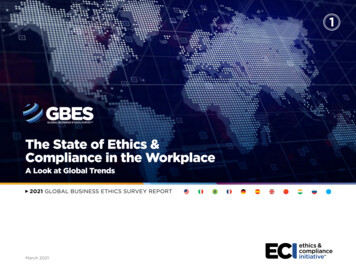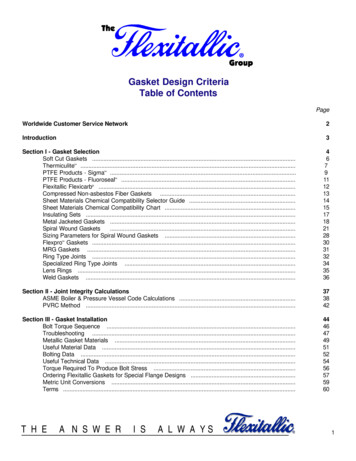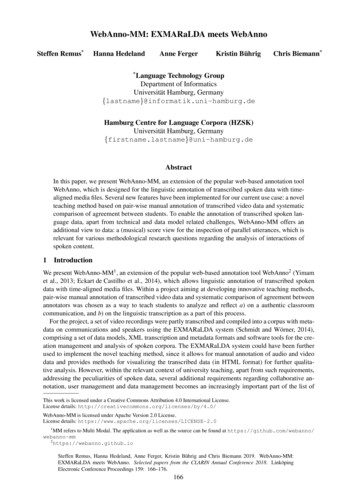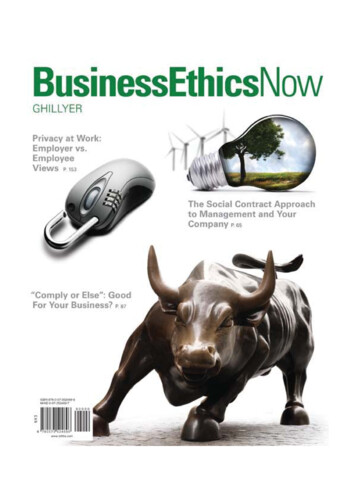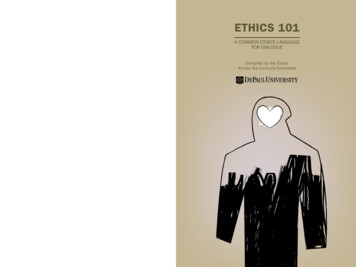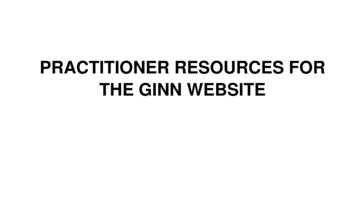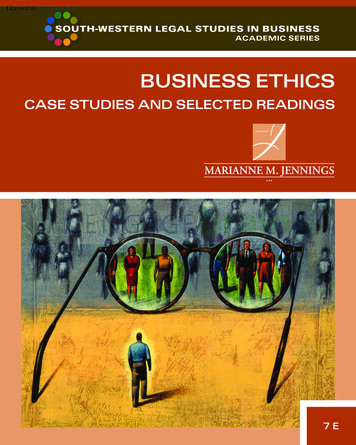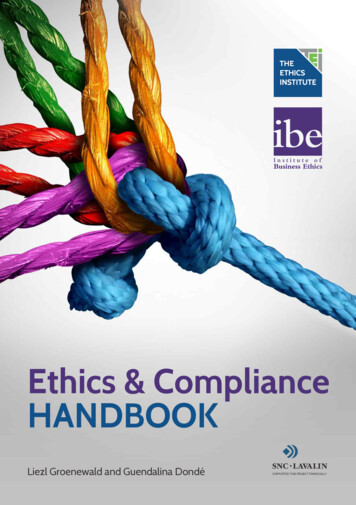
Transcription
Ethics & ComplianceHANDBOOKLiezl Groenewald and Guendalina DondéSUPPORTED THIS PROJECT FINANCIALLY
Authors: Liezl Groenewald and Guendalina DondéEditorial support: Prof Deon Rossouw and Philippa Foster Back CBECover design and layout: Lilanie Greyling (Dezinamite Visual Solutions)Publishing Editor: Monia Wadham (IBE)Ethics and Compliance Handbook The Ethics Institute (TEI) 2017 and Institute of Business Ethics (IBE) 2017ISBN 978-0-620-75268-8 printed copyISBN 978-0-620-75491-0 electronic copyPublished by: The Ethics InstituteHadefields Office Park Block E, 1267 Pretorius Street, Hatfield, Pretoria, South AfricaWebsite: www.tei.org.zaContact: info@tei.org.za The Copyright is the Creative Commons Copyright 2.5. It means:The Ethics Institute grants the right to download and print the electronic version, todistribute and to transmit the work for free, under three conditions: 1) Attribution: The usermust attribute the bibliographical data as mentioned above and must make clear the licenseterms of this work. 2) Non-commercial: The user may not use this work for commercialpurposes or sell it. 3) No change of text: The user may not alter, transform or build upon thiswork. Nothing in this license impairs or restricts the author's moral rights.The Ethics Institute reserves intellectual property rights of materials and processesgenerated by ourselves prior to or during the completion of this study. This includes (but isnot limited to) consultation processes, research instruments and reporting methodologies.
Ethics & ComplianceHANDBOOKLiezl Groenewald and Guendalina DondéSUPPORTED THIS PROJECT FINANCIALLY
AcknowledgementsA number of people have been helpful in producing this handbook. The authors aregrateful to the TEI and IBE teams for their support and advice. In particular, DeonRossouw (TEI Chief Executive Officer) and Philippa Foster Back (IBE Director)contributed practical help and advice on the content and style of this publication.The authors are particularly thankful to all those who agreed to be interviewed for thishandbook and provided their input and expertise: Graham Brunton (Group Ethics andCompliance Manager at Tullow Oil), Robert Smith (Director of Business Complianceand Ethics at Serco), Peter Montagnon (Associate Director at IBE), Osama (Sam) AlJayousi (Group Compliance Manager at Carillion) and Philip Jordan (Chairman of theEthics Committee at Total).The authors are very grateful to them and others who have been supportive.Other publications in The Ethics Institute's handbook series,available at www.tei.org.zaThe Social and Ethics Committee Handbook (2012)The Ethics Reporting Handbook (2014)The Ethics Risk Handbook (2016)
Table of ContentsAcknowledgementsForeword by The Ethics InstituteForeword by the Institute of Business EthicsRecognition of sponsorship: SNC-Lavalin234INTRODUCTION5About this handbookWho is this handbook for?Standardisation of terminology688PART 1:91.1Ethics and compliance: conceptual differencesValues and rulesPART 2:2.12.22.32.42.52.63.2DIFFERENT SIDES OF THE SAME COIN?The origins and development of the ethics and compliance roleThe respective responsibilities of ethics and compliance practitionersSimilarities in roles and responsibilitiesDissimilarities in roles and responsibilitiesFocusDifferent skills setsDifferent mindsets and approachesShared challengesAn 'image' problemExternal stakeholder trust in businessGetting the message heard at the top tableThe risk of combining ethics and compliancePART 3:3.1SETTING THE CONTEXTWORKING TOGETHERCollaboration at the governance levelThe governing bodyGoverning body committeesCollaboration at the operational levelWhat a productive collaboration looks LUSION46About The Ethics InstituteAbout the Institute of Business EthicsAbout the authors495051PAGE 1
Foreword by The Ethics InstituteBoth unethical and illegal conduct can cause organisations great harm, and jeopardisetheir sustainability. Consequently, responsible organisations have been implementingmeasures to protect themselves against illegal and unethical conduct. Sometimesorganisations opt for combining their defence against unethical and illegal conduct inone management function. This publication assesses whether it is prudent to combinethe ethics function and the compliance function in organisations, or whether it is betterto maintain ethics and compliance as separate, though complementary functions.The Ethics and Compliance Handbook forms part of the Ethics Handbook Series ofThe Ethics Institute. These handbooks are intended to provide those responsible forgoverning and managing ethics in organisations with useful and practical guidance.Since the governance and management of ethics can never be isolated from othermanagement functions in organisations, the Ethics Handbook Series explores theinterface and collaboration between ethics management and other managementfunctions – in this case, the interaction between the ethics and compliance functions inorganisations.As with all previous Ethics handbooks, The Ethics Institute has partnered with one of itsstrategic partners that has an interest in the theme of the specific handbook. In the caseof The Ethics and Compliance Handbook, we have opted for partnering with the Instituteof Business Ethics (based in London). In 2016 The Ethics Institute and the Institute ofBusiness Ethics signed a Memorandum of Understanding that provides for variousforms of collaboration. The Ethics and Compliance Handbook is the first fruit of thatcollaboration.I would like to thank the Director of the Institute of Business Ethics, Philippa Foster Back,for her unwavering support to this project. Furthermore, I would like to thank the coauthors of the book for their dedication and hard work to produce this very useful andmuch needed guidance on the ethics and compliance interface. Liezl Groenewald fromThe Ethics Institute acted as the project leader, and was very ably supported byGuendalina Dondé from the Institute of Business Ethics.I trust that The Ethics and Compliance Handbook will help organisations around theglobe to create positive synergy between the ethics and compliance functions in theirmutual pursuit of protecting their organisations against the risks of unethical and illegalconduct.Prof Deon Rossouw CD (SA)CEO: The Ethics InstituteETHICS AND COMPLIANCE HANDBOOK ForewordPAGE 2
Foreword by the Institute of Business EthicsThe international perspective this handbook gives on ethics and compliance and themanagement of the two functions is a timely insight. It is an often debated topic at IBEevents and in our advisory practice, as companies of all nationalities and in all sectorsoften struggle as to how they should run these important business functions. Thosecompanies that are regulated often see compliance as pre-eminent. Yet many havecome to recognise that to build a positive corporate culture it is important to establishthe right mindset. That mindset, which should be based on an ethical framework ofcorporate values to guide decisions and behaviours, will be encouraged by the creationof a separate ethics function and will lead to better compliance as a result.As this handbook illustrates, the two functions cannot work in isolation and need tocollaborate closely with each other and with other departments, given the centrality ofethics to a business within a defined governance framework. Through the work of theKing Committee and recently in the King IV Report on Corporate Governance for SouthAfrica 2016 this is set out. In the UK, the UK Corporate Governance Code is not currentlyprescriptive as to all companies being required to have a code of ethics or board levelcommittee to oversee its embedding. These matters are currently being debated.The Institute of Business Ethics is pleased to have collaborated with The Ethics Instituteon this handbook, and I thank and congratulate Liezl and Guen on this publication.Philippa Foster Back CBEDirector, Institute of Business EthicsPAGE 3
Recognition of Sponsorship: SNC-LavalinThe Institutes would like to thank SNC-Lavalin for its generous sponsorship towardsthe research, design and printing of this publication.Founded in 1911, SNC-Lavalin is one of the leading engineering and constructiongroups in the world and major player in the ownership of infrastructure. The companyhas a workforce of 35 000 employees spread over 50 countries. SNC-Lavalin teamsprovide engineering, procurement, construction, completions and commissioningservices together with a range of sustaining capital services in the four industry sectorsof oil and gas, mining and metallurgy, power and infrastructure.SNC-Lavalin is committed to doing business with the highest ethical standards andexpects its employees to act with integrity at all times. With this in mind, the companyimplemented a robust Ethics and Compliance Program across all its sectors andregions. Ethics and compliance principles, procedures and controls are firmlyembedded and integrated into all of the company's key operational processes.“Ethics and compliance is woven into the very fabric of our organization,” explains NeilBruce, President and CEO of SNC-Lavalin. “Our employees understand the importanceof maintaining exceptionally high standards of business conduct – it is part of the job.”In addition, SNC-Lavalin has designed customized training programs to raise employeeawareness on ethics and compliance issues at all company locations across the globe.Employees are empowered to think of themselves as ethics ambassadors and speakout if they see something that makes them feel uncomfortable.“Doing the right thing is fundamental to the business. Ultimately for SNC-Lavalin, ethicsand business success goes hand in hand. Acting ethically should be as natural asbreathing – you don't have to think about it: it's just the way you do business,” said DrHentie Dirker, Chief Compliance Officer, SNC-Lavalin.SNC-Lavalin is also involved in global initiatives aimed at promoting ethical business.We want to make a positive impact on the business environment in high risk regions. Itis in this context that SNC-Lavalin is proud to sponsor this Ethics and ComplianceHandbook.ETHICS AND COMPLIANCE HANDBOOK Recognition of sponsorshipPAGE 4
1Introduction
IntroductionAbout this handbookEthics and compliance practitioners represent a relatively young, but rapidly maturingprofession that has become increasingly important in many organisations, ascompanies all over the world have realised that addressing ethics risks, in addition tocompliance risks, is crucial to promote long-term sustainability. If it is true that thevalues that underpin the ethics of business are as old as business itself, the second halfof the twentieth century has witnessed a professionalisation of organisational ethics,and organisations created specific job roles with the task of overseeing and managingtheir newly created ethics and compliance programmes.In particular, these professions started to emerge in the USA during the late 1970s and1980s, as a self-regulatory response of business to significant corporate scandals thatprompted the government to issue pieces of regulation, such as the Foreign CorruptPractices Act in 19771. Professionals that developed in this context were required tofocus on ensuring compliance with the law, whilst the attention to a purely ethicalaspect developed at a later stage.Elsewhere, a different approach was adopted. In the UK, a business ethics approachwas taken with the formation by business people of the Institute of Business Ethics in1986 and Sir Adrian Cadbury's Corporate Governance Code (1992) Financial Aspects ofCorporate Governance2. In 1994 the Institute of Directors of Southern Africa (IoDSA)introduced the First King Report of Corporate Governance for South Africa (King I).3Since then a number of regulations, best practice codes and legislation havematerialised that underscore the importance of ethics and compliance practitioners inbuilding ethical organisational cultures.These different perspectives have had an impact on the way in which organisations allover the world have organised their ethics and compliance functions. In practice thetitles and job responsibilities of ethics and compliance professionals vary significantly(see Part 2), but it is undeniable that they, having been charged with the responsibility ofleading an organisation's efforts to protect itself from ethics and compliance risks, havea unique and special role in an organisation.In general terms, it can be observed that many organisations, especially in the USA andin Europe, tend to combine ethics and compliance under the remit of a single function.In South Africa the preference appears to be for separating the ethics function from thecompliance function, mainly due to the influence of the Third King Report on CorporateGovernance for South Africa, 2008 (King III). However, the research conducted for this1The United States Department of Justice, Foreign Corrupt Practices Act of 1977, as amended,15 U.S.C. §§ 78dd-1, et seq. (FCPA)ETHICS AND COMPLIANCE HANDBOOK IntroductionPAGE 6
booklet shows that many organisations are debating internally the best way to manageethics and compliance risks, questioning their current frameworks. While ethicalaspects seem to gain prominence over compliance issues in many US corporations,some multinationals with subsidiaries or offices in South Africa tend to merge ethicsand compliance within the same function.This handbook explores the different roles of ethics and compliance practitioners inpromoting ethical conduct in organisations, and analyses benefits and drawbacks ofthe two approaches to understand whether it is more effective for organisations tohave two separate functions dealing with ethics and compliance respectively. It isbased on desktop research and interviews with senior ethics and compliancepractitioners with global responsibilities in a range of industries based in South Africa,the UK and Europe.“It is important thatall employees should knowwhat standards of conduct areexpected of them. We regardit as good practice for Boardsof Directors to draw up codesof ethics or statements ofbusiness practice and topublish them both internallyand the UK.”Committee on the FinancialAspects of CorporateGovernance (1992)2The Committee on the Financial Aspects of Corporate Governance, chaired by Sir Adrian Cadbury (1992)Financial Aspects of Corporate Governance3IoDSA, King I Code of Corporate Governance in South Africa 1994PAGE 7
Who is this handbook for?This handbook is aimed primarily at two principal audiences, namely:1.2.Governing bodies and senior executives who seek to understand how to manageethics and compliance effectively; andEthics and compliance practitioners who seek to understand the scope andresponsibilities of their roles.Other secondary audiences include, but are not limited to: Social and EthicsCommittees (in South Africa), Operational Ethics Committees, Risk ManagementCommittees, Internal Audit, Legal, and Human Resources.Standardisation of terminologyDifferent sectors and industries employ different structures and naming conventionsfor the governance of ethics and compliance. To avoid unnecessary repetition, thefollowing umbrella terms will be used throughout this handbook:· Governing body (equivalent of a board of directors of organisations [“ the bodywho has primary accountability for the governance and performance of theorganisation”])4· Chief executive officer (managing director)· Ethics governance committee (equivalent of Social and Ethics Committee in SouthAfrica, Ethics and Compliance Committee or other governance bodies tasked withthe governance of ethics and/or compliance)· Compliance committee (Ethics and Compliance Committee or other governancebodies tasked with the governance of compliance)· Ethics practitioner (ethics director, ethics manager, ethics officer, ethics advisor,integrity manager, etc.)· Compliance practitioner (compliance director, compliance manager, complianceofficer, etc.)4Institute of Directors (2016) King IV Report on Corporate Governance for South Africa, p. 12.Available at www.iodsa.co.zaETHICS AND COMPLIANCE HANDBOOK IntroductionPAGE 8
Part 1Part1SettingtheSetting theContextContext
Part 1: Setting the Context1.1Ethics and compliance: conceptual differencesChief Justice of the U.S. Supreme Court Potter Stewart once stated: “Ethics is knowingthe difference between what you have the right to do and what is right to do.”5 This is, inessence, the main distinction between ethics and compliance, two concepts that areotherwise often closely associated, particularly in the business world.As table 1 shows, the common denominator that links the two concepts is the need toexplain and influence the way in which people at work behave ('doing the right thing').The approach to this, however, can be diametrically opposed. Whereas ethics impliesthat people will behave in accordance with a system of common values that are agreedand shared, compliance means that people must do what they are told to do, either bylaw or by their superiors. It follows that ethics indicates that individuals need to rely ontheir own personal judgement to discern right and wrong, often questioning why theyare encouraged to behave in a certain way. Such considerations are far less prominentin the definition of compliance.GLOSSARYEthicsCompliance1. a system of accepted beliefs thatcontrol behaviour, especiallybased on morals2. the study of what is morally rightand what is not1. the act of obeying an order, rule,or request (formal)2. the state of being too willing todo what other people want you todo (mainly disapproving)Table 1: Definitions of ‘ethics’ and ‘compliance’ from the Cambridge English DictionaryThis distinction becomes even more evident when it is applied in a business context.According to the Cambridge Dictionary of Business English, compliance is “the fact ofobeying a particular law or rule, or of acting according to an agreement”. On the otherhand, the IBE defines business ethics as “the application of ethical values to businessbehaviour” and, according to Rossouw and van Vuuren, business ethics “refers to thevalues and standards that determine the interaction between business and itsstakeholders”.6 A number of considerations stem from these definitions; the remainderof this section addresses the most relevant of those.5Coffey R. (2013) Ethics for community planning, US: Michigan State University ExtensionRossouw, D. and van Vuuren, L. (2013) Business Ethics, Cape Town: Oxford University Press South Africa,chapter 1, p. 56ETHICS AND COMPLIANCE HANDBOOK Part 1PAGE 10
DID YOU KNOWThe 'Golden Rule'7In an international context, whilst the law of the country where the companyoperates provides a good framework for compliance, the understanding of howethics should be applied in practice can vary significantly in different cultures.A common example is the provision of gifts and entertainment, which are seenas a fundamental part of doing business in some countries but interpreted as anunacceptable way of influencing business in others. The so-called 'Golden Rule'– “Treat others as you would like them to treat you” – can provide someguidance on this and can be used relatively easily to determine whether anaction would be regarded by both parties as ethical.Values and rulesIf the definition of compliance is focused on laws and rules, the key element ofbusiness ethics is values. By definition, the law consists of a number of norms whichconstitute obligatory rules of behaviour that apply to all members of a society. It can beargued that these legal norms are closely related to ethical values, in the sense that thelaw represents the expression of the ethical values that guide society.To understand this relationship better, it is important to analyse the different factorsthat contribute shaping the ethical values in business and society. Figure 1 e 1: Types of values78ProfessionalvaluesCorporate ororganisationalvaluesIBE Report (2014) Towards Ethical Norms in International Business TransactionsIBE Core Series (2016) Codes of Business Ethics: a guide to developing and implementing an effective codePAGE 11
· Societal values are those shared by members of a community. They define thecollective identity of a specific community and might find expression in, for example,political parties, and cultural or religious groups. Societal values might evolve overtime and change as societies and their economies integrate in a globalised world.Laws and regulations can be seen as one possible expression of these values.Societal values in practice: the EUThe European Union's fundamental values are respect for human dignity andhuman rights, freedom, democracy, equality and the rule of law. These values uniteall its member states – no country that does not recognise these values can belongto the Union. Its main goal is to defend these values in Europe and promote peaceand the wellbeing of its citizens. For its part, the European Parliament seeks toensure that these values are enshrined in EU legislation.· Professional values are those defined by a professional body and determine thestandards of behaviour that members need to live up to in order to fulfil the purposeof their profession effectively (e.g. accountants and lawyers).Professional values in practice: the Hippocratic OathA traditional example of the codification of professional values is the HippocraticOath, an oath historically taken by physicians. In its original form, it requires a newphysician to swear to uphold specific ethical standards. Of historic and traditionalvalue, the oath is considered a 'rite of passage' for practitioners of medicine inmany countries. Although nowadays various modernized versions are often used,the general rule is still the same everywhere: "Do no Harm.”· Corporate or organisational values are the values that an organisation expects itsemployees to apply when they carry out their jobs. All organisations operate on thebasis of a set of core values, be they explicit or not, which describe 'how business isdone around here'. Such values, usually a combination of strategic, work and ethicalvalues, form the basis of corporate codes of ethics and the related policies.ETHICS AND COMPLIANCE HANDBOOK PART 1PAGE 12
Corporate values in practice: the oil, gas and petroleum industryTOTALSASOLRespect: the source of sustainable,trust-based operations and relationsResponsibility towards others and inour jobsExemplary behaviour, whichunderpins the internal and externalcredibility of our actions andinitiatives.Safety: We are committed to zeroharm and all that we do, we do safely.People: We create a caring, engagedand enabled work environment thatrecognises both individual and teamcontributions in pursuit of highperformance.Integrity: We act consistently on a setof values, ethical standards andprinciples.Accountability: We take ownership ofour behaviour and responsibility toperform both individually and inteams.Stakeholder focus: We serve ourstakeholders through quality products,service solutions and value creation.Excellence in all we do: We deliverwhat we promise and add valuebeyond expectations.· Personal values are the principles and beliefs that are important in the life of anindividual and guide people in the choices they make, both in the workplace andoutside. They are influenced by a number of factors and they might vary considerablyfrom person to person within the same organisation.Personal values in practice: your employee's personal valuesCompanies tend to appreciate the importance of understanding the personalvalues that drive their employees. Some users of Glassdoor, a website whereemployees and former employees can anonymously review companies and theirmanagement, report that in their selection interview they were asked to explain“What are your personal values, how do they align with the firm, and why do youwant to work here?” Another user explains that he chose his current companybecause it is “a workplace that aligns with my personal values.”It is worth noting that the different sets of values outlined above do not representseparate entities, but they are closely interrelated and influenced by one another. Froman organisational perspective, understanding what people and society value, and howthis impacts on employee behaviour, is essential. This is ultimately the key point thatethics and compliance have in common.PAGE 13
Part 2Different Sides ofthe Same Coin?
Part 2: Different Sides of the Same Coin?2.1 The origins and development of the ethics andcompliance roleAs mentioned in the introduction, a number of factors influenced the way organisationsworld-wide have developed their internal frameworks to manage ethics andcompliance. A particularly important aspect that informed a number of legislativeinterventions, especially in the USA, is linked to the fight against bribery and otherforms of corruption in business, allowing organisations to bring the effectiveness oftheir ethics and compliance programmes as mitigating evidence in court. Suchmeasures often address ethics and compliance as a single function. The US FederalSentencing Guidelines of 1991 allowed organisations with effective ethics andcompliance programmes to reduce fines by up to 95%, and penalised those withouteffective programmes by increasing fines by up to 400%. This assisted in creating acommonly shared identity for the emerging US-based model of ethics and compliance.The formation of the Ethics Officer Association in 1991 (later the Ethics andCompliance Officer Association) lent impetus to this model and it was furtherstrengthened by the Sarbannes-Oxley Act of 2002 which required that corporationsincorporate ethics in the organisations.Outside the US, multinational and large organisations, especially in Europe, adoptedthe US model, albeit sometimes adapted to fit their business. Global business, globalservice providers and “cross-border legislation such as the US Foreign CorruptPractices Act 1977 and the UK Bribery Act 2010, have all provided a means by whichethics and compliance program 'orthodoxy' has spread” suggests Fiona Coffey, authorof a report on the role and effectiveness of ethics and compliance practitioners.9In South Africa, King III laid the foundation for the establishment of ethics managementstructures and the appointment of someone responsible for managing ethicsprogrammes in organisations because of its premise that corporate governance isgrounded in an ethical foundation. King III also set guidelines on the management ofethics in organisations. The Fourth King Report (King IV) (2016) holds this same view.Although the King Codes are not enforceable through legislation, complying with theprinciples of the Code is a requirement for listed companies in South Africa. King IIIdeliberately did not advise that ethics and compliance should be combined, but ratherhighlighted that although ethics and compliance should interact, ethics is about actionbeyond compliance. Following the King III recommendations, a notable number ofSouth African organisations appointed ethics practitioners whose task is to developand implement ethics programmes in view of embedding organisational values intotheir culture. Ethics practitioners are trained and certified by TEI to fulfil their ethicsmanagement responsibilities as advised by leading global experts in the field of9IBE Report (2014) The Role and Effectiveness of Ethics and Compliance PractitionersPAGE 15
business ethics, as well as the King Codes. This training encompasses very fewaspects of regulatory and legal compliance and is focussed on equipping ethicspractitioners with the know-how of institutionalising ethics.DID YOU KNOWThe South African Business Ethics Survey 201610 found that nearly two thirds(58%) of employees in large South African organisations know that theirorganisation has an ethics practitioner who is solely responsible for managingthe ethics programme; and 73% said that their ethics practitioner makes adifference in the organisation.In the UK, views appear to be somewhat mixed. Although a number of UK-basedorganisations seem to adopt the model prevalent in the US of combining ethics andcompliance, the debate is still ongoing and a number of commentators havequestioned the validity of such an approach. An example of the latter is provided by theSalz Review, an independent review of Barclays' business practices after the Liborscandal, which states that “moral intuition disappears by a context which clouds ourintuition and encourages compliance behaviour instead of thinking and soundjudgment”.11 In addition, the IBE has argued that this distinction has a significant impacton the ability of organisations to restore public trust. Governments and the businesscommunity need to consider that “while regulation is needed to prevent abuse andensure orderly behaviour, it will not on its own deliver trust. Indeed, the need forregulation implies a lack of trust because it suggests that organisations will not do theright thing, unless they are forced to. More regulation and an even greater focus oncompliance is not the answer. [ ] The key imperative for policy makers concerned withculture and ethics should be to ensure they have a framework in place whichencourages companies to make good decisions for themselves.”1210TEI (2016) The South African Business Ethics Survey 2016. Available at: h-reports11De Klerk, M. (2015) 'Should ethics and compliance be combined or separated?' Available at: e-be-combined-or-separated12IBE Survey (2016) The Institute of Business Ethics: the next 30
of The Ethics and Compliance Handbook, we have opted for partnering with the Institute of Business Ethics (based in London). In 2016 The Ethics Institute and the Institute of Business Ethics signed a Memorandum of Understanding that provides for various forms of collaboration. The Ethics and Compliance Handbook is the first fruit of that

